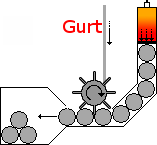Seat belt tensioners
The belt tensioner , like the airbag , is one of the so-called passive safety systems of a vehicle . Its task is to tighten the seat belts in the event of an accident so that the vehicle occupant can participate in the overall deceleration of the vehicle earlier . To do this, the belt is tightened by up to 15 cm within approx. 10-15 milliseconds. This is particularly useful when thick clothing prevents the belt from being tight against the body.
The belt tensioner can either be integrated in the belt retractor, below the belt lock and / or at the anchoring of the belt. Either a tensioned spring or a small explosive charge is used as energy supplier .
When used properly, current belt tensioners apply approx. 2 kN of force to the shoulder when the belt is already tight. If used properly, this only leads to injuries in exceptional cases. The so-called belt force limiter was developed so that the forces do not increase too much after the belt has been tightened in the forward displacement phase of the occupant .
process
The airbag control unit triggers the seat belt tensioner when it receives information about a collision from the sensors . Under certain circumstances, the deployment threshold can be lower than that of the airbag, for example at low speed. It can therefore happen that the seat belt tensioner is triggered but the airbag does not. In modern cars, sensors also check whether someone is in the seat and whether the seat belt is on. If this is not the case, the release does not take place.
There are several types of belt tensioners:
- Rotary tighteners are relatively common. The control unit triggers a pyrotechnic propellant charge in the belt retractor , the gas pressure of which accelerates steel balls in the retractor. This release their kinetic energy to a gear on the shaft from the belt retractor. The rotation of the gear further rolls up the belt, which then rests tightly on the passenger. With the seat belt lock version , the gas pressure of the propellant charge is released to a piston under the seat, which suddenly pulls the seat belt lock back and down via a steel cable, thus tightening the belt.
- Other modes of operation are, for example: rope tensioners, pipe tensioners and Wankel tensioners (a rotary piston engine, similar to the Wankel engine ). Instead of a pyrotechnic propellant charge, a tensioned spring can also apply the necessary force.
- A modern, but comparatively expensive version is the reversible belt tensioner. In addition to the pyrotechnic belt tensioner, an electric drive is used, which can tighten the belt with less force (for example 100-200 N). Due to its multiple uses, the reversible seat belt tensioner can already be used during a dangerous situation without actually having to lead to an accident.
disadvantage
A pyrotechnic seat belt pretensioner, like the airbag, can only be used once. A triggered belt tensioner is indicated by some car manufacturers by a yellow or red tab on the belt tensioning mechanism.
As with the airbag, when a vehicle is scrapped, special safety rules for dismantling must be observed so that the belt tensioning mechanism is not accidentally triggered and this leads to injuries. A belt tensioner can also be problematic for patient-friendly rescue , as it can be triggered when the B-pillar is cut with the scissors and can injure the patient or emergency services. The B-pillar should therefore be cut as high as possible (above the belt tensioner).
The basic rule is that the seat belt in the car should be tightened as tightly as possible and must not be twisted under any circumstances. Otherwise injuries from the belt can occur in an accident .
